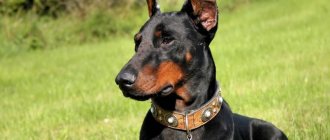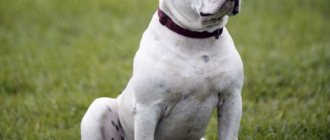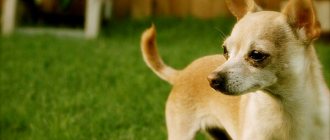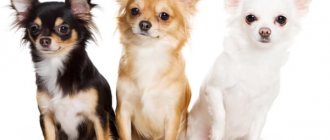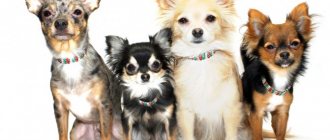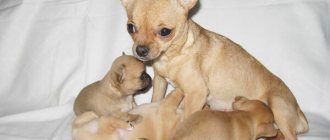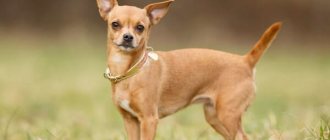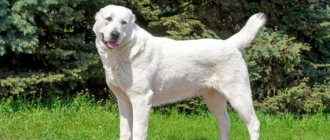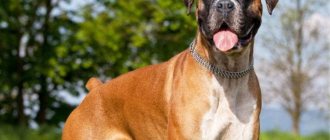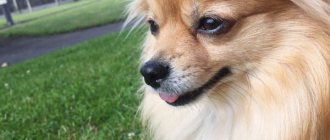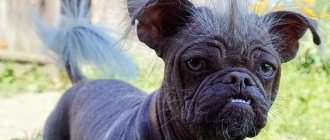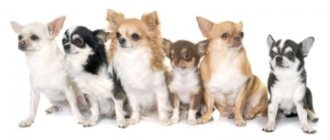The Chihuahua is the smallest dog with a toy appearance and a cheerful character. Its popularity has recently been at its peak despite the fact that the breed has been known for a long time. The first mentions in the form of images of Chihuahuas date back to the third century BC. They were discovered in Mexico, the largest state of which gave the dogs their name.
The Chihuahua breed standard was approved by the FCI and RKF in the middle of the last century. An owner who plans to take part in prestigious exhibitions with their pet must know them and choose a puppy according to the prescribed requirements.
General appearance of the breed
All representatives of the Chihuahua breed are very small animals. This mini breed has an elegant appearance as well as a compact body. It is worth noting that such an indicator as the height at the withers corresponds to the weight of the pet.
Dogs of this breed are distinguished by the fact that the tail is always curled in a semi-ring. At the same time, he must look towards the lower back. The main distinguishing feature of this mini-breed is the special structure of the skull. A small gap forms between its bones, called a fontanel. It almost never completely overgrows. However, in addition to appearance, the Chihuahua has a certain breed standard.
Brief breed historical information
The breed first came to attention in the mid-19th century in the Mexican state of Chihuahua .
. Chihuahua), after which it is named.
There is an opinion that the ancestors of the modern Chihuahua are ancient small dogs of the Techichi breed, who lived and domesticated during the existence of ancient peoples: the Toltecs, Aztecs and Mayans.
This is evidenced by archaeological finds found throughout Mexico in the form of figurines depicting a small dog, similar in appearance to a modern Chihuahua. Historical examples date from the 9th century AD.
Techichi was a sacred animal, sacrificed to the gods, and served as food and a small pet for ancient Indian tribes. Read more in the article: history of the Chihuahua breed.
The Chihuahua first appeared at the American Dog Show in 1904 in Philadelphia. The representative of the breed was a smooth-haired female named Midget, acquired on the Mexican border by Mr. Reiner.
In 1923, the National Chihuahua Club was founded and the first breed standard was developed, which included only the smooth-haired type.
In the 1930s, Texas breeders developed the longhaired variety.
In 1954, the Chihuahua standard was revised to include representatives of both species (smooth-haired and long-haired). Subsequently it was adopted by the RKF (Russian Cynological Federation).
Since 2010, no changes or additions have been made to the official document.
Compliance of a Chihuahua dog with the standard is mandatory if the owner plans to:
- participate in breed dog shows;
- engage in breeding work to breed purebred puppies with a pedigree;
- become a member of the NCP (National Breed Club).
Based on the criteria below, the judges determine the dog’s compliance with international standards for the Chihuahua breed and decide on the admission of a potential participant to participate in the exhibition.
A dog's compliance with the generally accepted standard indicates its purebred origin. Otherwise, an exterior class is assigned according to the degree of the defect: “breed” or “pet”.
Standard sizes
One of the most important parameters of the standard is the size of the dog. Animals reach their maximum size before the age of 12 months. Most often, pets grow up to 6 months, and then only gain weight. Males weigh about 1.3–2.7 kg, and females – 1.5–2.7 kg. However, the weight of the largest representative reached 6 kg!
The standard does not precisely specify the height of an adult dog. Usually this parameter varies over a fairly wide range - from 15 to 23 cm at the withers. Whatever the size of the Chihuahua, they still do not go beyond the range established in the standard. The most popular are the short Chihuahuas. Height depends on the breed variety.
Chihuahua price
The price of a dog depends on several factors:
- floor;
- size;
- wool length;
- color;
- presence of a passport and pedigree.
You can buy a Chihuahua puppy either from a private person or from a nursery. The second option will cost more, but it is much more reliable. If it is important to purchase an elite class dog, then it is better to contact an experienced breeder.
Females are always cheaper. The presence of a pedigree increases the cost of a puppy by a decent amount.
The price for a Chihuahua in a nursery varies from 25 to 50 thousand rubles. Thus, a puppy with minor deviations from the norm can be purchased for 25 thousand. A show class dog will cost more. For private breeders, the price tag starts at 4 thousand rubles.
What should the proportions be?
In addition to size, the standard for a given breed determines the proportions of the animal's body. The height at the withers should be slightly less than the length of the body. Males have an almost square body shape, while females have a more elongated body shape (due to the need to bear offspring). Such proportions are observed in both small and larger representatives.
We recommend this article:
How to choose a healthy Chihuahua puppy
Character
In general, we can say that the character of the Chihuahua is calm, but there are situations in which a cute dog turns into an aggressive animal. For example, it has been observed that sneezes are intolerant of representatives of other dog breeds. A small dog can easily attack a large shepherd. This can lead to injury and even death to the miniature daredevil. It is interesting that this dog behaves peacefully with other sneezes and enjoys playing with its own kind.
The sneeze is attached to the owner, the greatest happiness for him is to be nearby, to observe what he is doing. For older people, Chihuahuas are a real find. A dog can calmly lie on the lap of its beloved owner for hours. It is better not to leave him with small children; children may accidentally injure the dog, and the dog, in turn, may bite the child in self-defense.
Adults prefer to spend time in peace and quiet. Puppies, on the contrary, are ready to run, jump, and play games with similar pets or with household members for days. When you go on a trip, you can without a doubt take your Chihuahua with you. The dog is able to easily endure travel, sitting comfortably in the arms of the owner or sitting in a special carrier bag.
The sneeze is suspicious of strangers, so it makes a wonderful watchman. Possessing a quick reaction and good hearing, dogs of this breed are able to recognize the owner’s car by alarm and recognize not only his voice, but also the sound of footsteps. It is easy to recognize who is behind the door by sneezing.
For its love and devotion, a pet will require the same attitude towards itself. He cannot stand loneliness; if left alone, he will bark loudly in protest. We can say that the dog is too affectionate. She will come up with any ways to draw the attention of household members to herself. If you cannot devote enough time to a small pet, buy not one, but two sneezes or a representative of a different breed.
Head standard
Chihuahuas are distinguished by a large skull, which is apple-shaped. In this case, the height and width of the skull are equal. There are also pronounced brow ridges. The convexity of the forehead noticeably extends to the muzzle. The animal's head is wide at the base, but narrows towards the nose. The cheekbones on the muzzle are poorly defined and rounded. The lips fit tightly and are characterized by a tense structure. At the same time, they must cover the teeth completely.
The nose is small and slightly upturned. The RKF standard allows for any color of the nose. The main thing is that it matches the color of the coat. The eyes of animals are expressive, round and large. On the face they are widely spaced. There is a deep groove between them. The look is slightly sly. The eye color is dark and goes well with the coat color. However, according to the standard, light eye color is also allowed. Along it, the eyes and nose should form an equilateral triangle.
The Chihuahua's bite is straight, but can also be scissor-shaped. The defect will be an overshot or undershot. As for teeth, their number is not regulated. It may be incomplete. The ears are located quite high. They are wide at the base, but taper towards the apex. The tip is rounded. When at rest, the ears hang at an angle of approximately 45 degrees. When the dog is excited, they rise straight up. At the same time, the distance between them decreases. The difference in ears between different representatives of this breed is minimal.
The head is located on an elongated neck, on top of which there is a characteristic small-sized bend. There is no suspension. Males have a more powerful neck compared to females.
Maintenance and care
Such small creatures of nature as Chihuahuas are not at all difficult to care for. Due to their small size, dogs are ideal pets that can be kept in an apartment, even in the smallest one-room apartment.
The very first thing you need to do when buying a puppy is to determine its place in the house. It should be a non-passing, draft-free, fairly warm but not hot place. Lay a mattress there or install a bed. For small breeds such as Chihuahuas, you can purchase a beautiful house. The dog should feel protected on its territory; if it goes to rest in its place, do not disturb or forcibly pull it out of there.
A sneeze, running from room to room several times, fully satisfies your needs for physical activity. But locking a dog indoors without walking for several days, or even weeks, is unacceptable. Chihuahuas love walks in the fresh air; a loving owner should not deprive them of daily short walks, during which the following rules must be observed:
1. It is not advisable to let a miniature and fragile sneeze off a leash. It must be monitored at all times, otherwise the dog may inadvertently get injured or end up in an unpleasant, dangerous situation. 2. Excessive physical activity can harm the dog. Stairs, barriers, and steep climbs are contraindicated for a small pet. Due to such obstacles, the animal's spine may suffer. Therefore, the owner must carry the dog in his arms in such cases. 3. Chihuahuas are known as very neat dogs who will never allow themselves to “walk” through puddles. The owner will have to carry the pet through puddles in his arms. 4. Representatives of the breed are aggressive towards other breeds. While walking, you need to make sure that your small dog does not come into conflict with the big one. Such communication can end tragically for a sneeze.
Caring for Chihuahua fur is not difficult, you just need to take into account the difference in caring for short-haired and long-haired representatives of the breed. The difference lies in the time that the owner will need to spend on caring for the coat.
Long-haired dogs are brushed 4-5 times a week; daily brushing will not hurt. They molt twice per season. During this period, it is necessary to comb the coat every day.
Smooth-haired dogs should be brushed twice a week. During shedding, brushing should be done at least four times a week.
Hygiene procedures are carried out regularly and on time; they are practically the same for both long-haired and short-haired varieties:
- Brush your teeth regularly or buy your dog special teeth brushing bones.
- Bath 2-4 times a year using special detergents for dogs. The exception is heavy soiling and washing dirty paws after walks.
- If you give your dog baths too often, his coat may lose shine and become dandruff.
- Claws are trimmed twice a month.
- The ears are cleaned and examined once a week. Cleaning is carried out using cotton swabs. An examination is necessary to detect excessive discharge in time; they can be symptoms of various infections.
Chihuahuas are known for their excessive tear production, which is why these dogs have tear tracks near their eyes. You need to regularly wipe your eyes with a napkin soaked in a special liquid. You can purchase it at any veterinary pharmacy. You need to carry out this procedure with your eyes twice a week.
Chihuahuas need warm clothing. Especially in the autumn-winter period. Special stores sell all types of clothing and shoes for dogs. Owners of these little pets buy outfits for them not only to keep them warm during walks, but also for fashionable decoration. On holidays, the dog dresses up in a carnival costume; in the evening, in the room, the dog is dressed up in pajamas and slippers; for walks, the dog’s wardrobe includes jackets, overalls, boots, etc.
Ideal case
The body of this breed must be harmoniously and firmly built. A slight elongation is not considered a defect. The back is strong and level. It goes into the muscular lower back. The croup itself is wide with a slight slope. The chest is quite wide with rounded ribs. The chest itself is also rounded to the elbow of the front legs, forming a characteristic barrel-shaped shape with a tucked belly.
Related article: How to choose a healthy Chihuahua puppy
There are two types of housing:
- dir – elegant or “deer-like”;
- cobby - heavy.
The tail of all Chihuahuas is of average length and is set high. It is thick at the base, tapering towards the apex. A Chihuahua without a tail is considered a defect.
Main types of colors
The most common colors are:
- Ginger . A gradation from red to light red fur is acceptable. It is almost impossible to meet a completely red dog. It goes with other colors. These may be white spots. “Red sable” suggests hairs with dark tips (shown in the picture).
- Black. All-black Chihuahuas are just as rare as red ones. Most often, a dog is born black and tan. There are also black Chihuahuas with white markings on the chest and toes. Black and tan Chihuahuas with milky spots on the chest, legs and tip of the tail are popular.
Rare colors of Chihuahua (shown in the photo):
- Chocolate. Brown dog with a red tint. Dogs come in pure color, or also with small light markings. Various shades of chocolate, sable, and chocolate tricolor are allowed.
- White. Found only in its pure form. There should be no large marks or stains on the fur.
- Brindle . This color allows for a large number of variations. For a Chihuahua, this is fawn in any gradation, thick black. Different types of patterns on wool are acceptable.
- Lilac. A very beautiful color that is quite rare. The shade can be of any saturation. When the color is so light that it looks like pink, it is called “Isabella.” A purple tricolor is allowed.
- Blue. The blue Chihuahua can be dark, almost gray, or smoky. White patches on wool and tricolor are allowed.
Prohibited color of Chihuahua:
- Merle, or marble. The wool looks as if it is unevenly dyed black, dark gray or beige, which is why the marbled effect is created. The eye color of these dogs is watery blue. Puppies with this color are often born blind, deaf, or without eyes or ears at all. Often offspring with such a gene die in the womb or at birth. If the individual grows, its sterility may be revealed.
Experts believe that this gene appeared in Chihuahuas from crossing with dachshunds, which are carriers, since it does not harm their health.
Miniature Breed Limbs
A characteristic feature of the Chihuahua is its strong and stable front legs, parallel to each other.
If you can notice a difference between them, then this is a defect. Looking at the animal from the side, it becomes noticeable that the metacarpus is slightly oblique and elastic. The elbows should be pressed tightly against the body.
The hind legs are also well developed. Characterized by a vertical posture with a parallel arrangement. The limbs have soft paw pads. Long fingers with slightly elongated claws.
Coat
The Chihuahua's coat can be either short or long. Dogs with short hair have soft hair. The fur fits very tightly to the body. If there is an undercoat, the hair is longer. This is usually clearly visible on the tail and neck. Usually short hair is observed on the ears and head. In the throat area it is almost absent.
Long-haired representatives have a smooth coat. It is soft and thin. Small waves may form. The longest hair is located on the paws, neck, ears, chest and tail.
Nutrition
Decorative lap dogs in most cases have a sweet tooth; they love to bite and beg for food from their owners when they eat. You should not follow the lead of gluttonous pets. Their diet must be controlled. Poor nutrition can lead to health problems such as obesity. The stomach may also suffer due to harmful foods. To prevent such troubles from happening, follow the following rules for feeding your Chihuahua:
- Food must be fresh.
- If food is prepared for several days, store it in the refrigerator.
- Food should be at room temperature.
- Portions should be the same.
- If there is food left in the bowl, it should be removed before the next feeding, giving your pet 20 minutes to eat.
- If a dog refuses a certain type of food, you cannot indulge such whims. When your pet gets hungry, he eats everything and will no longer be capricious.
If you decide to feed your dog natural food, check out the lists below. These recommendations will help you create the right diet for your pet.
Products that are healthy for dogs:
- Cereals - porridge should be well boiled and made from rice, millet or buckwheat groats.
- Meat – lean meats should be fed every day. By-products or boiled fish can replace meat twice a week.
- Vegetables – recommended boiled or stewed.
- Eggs – once a week, boiled.
- Fermented milk products – kefir, low-fat cottage cheese, fermented baked milk, bio-yogurt.
- Fruits – it is preferable to feed bananas and apples in fresh chopped form.
Prohibited products:
- Fatty meats put a lot of stress on the liver.
- Legumes – provoke intestinal spasms and bloating.
- Sausages contain a high content of additives harmful to dogs.
- Sweets lead to excessive tearing, indigestion and tooth decay.
- Fresh cabbage causes bloating.
Not every dog owner can find the time to prepare natural food for their pet. In this case, he is transferred to dry food. This method of feeding has its advantages: it does not require much time for preparation, contains all the vitamins and microelements, and is balanced.
You should only buy dry food from trusted outlets that specialize in selling professional food. If your dog has health problems, your veterinarian will recommend a special medicated food. In other cases, you should purchase super premium food.
Clean, cool water should always be available. It is recommended to install containers for food and water in special stands, so that the pet will not be able to turn over or move the filled dishes.
Main disadvantages
Any deviation from the accepted standard is a serious drawback. These include:
- flat or narrow skull;
- long and large muzzle;
- strong protrusion of the eyes or their small size;
- pointed or floppy ears;
- small neck;
- concave as well as curved spine;
- elongated body;
- misaligned jaw;
- small breast volume;
- completely thinning hair;
- sloping croup;
- narrow set of paws, as well as their curvature, etc.
Related article: What you can and cannot feed your Chihuahua at home
The presence of the above deviations affects the cost of the animal.
How to choose a puppy
When buying a puppy, first of all, you should pay attention to the appearance of the dog. She should look well-fed and strong. A healthy animal's coat is always smooth and silky, without bald spots.
The puppy's belly should be checked for an umbilical hernia. Ideally, it is always soft, without compaction.
It is better to purchase a pet from trusted sellers. You should not contact dubious retail outlets - markets, bazaars, private breeders. It is imperative to pay attention to the living conditions of the puppies.
A good breeder will always provide all the necessary information about both the puppies and their parents.
The Chihuahua's head should be apple-shaped, the forehead should be convex, and the muzzle should be relatively short. Only non-purebred individuals have muzzles that are too long. The puppy's ears must be clean, free of pus and irritation. A healthy pet's nose is always wet. Eyes – no discharge. The look is clear.
The skin should be absolutely healthy, without visible irritation or rash. Each paw should be felt and checked for dislocations and fractures.
Breed defects
The main defects of the breed include:
- light build;
- absence of a tail;
- the presence of bald patches on the body;
- heavy weight (from 3 kg);
- long ears and tail;
- extended body;
- in males - underdeveloped testes or not descended into the scrotum, absence of testicles.
Knowing what parameters in the Russian standard are typical for a Chihuahua, you can quickly determine the purebred nature of the purchased pet. The above parameters of the breed standard will help you choose the future winner of the exhibitions.
We recommend this article:
Who is better and who to choose: Chihuahua or Toy Terrier
